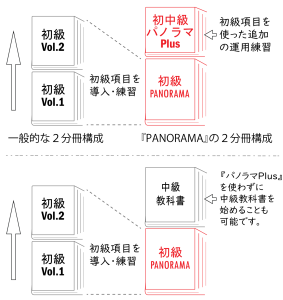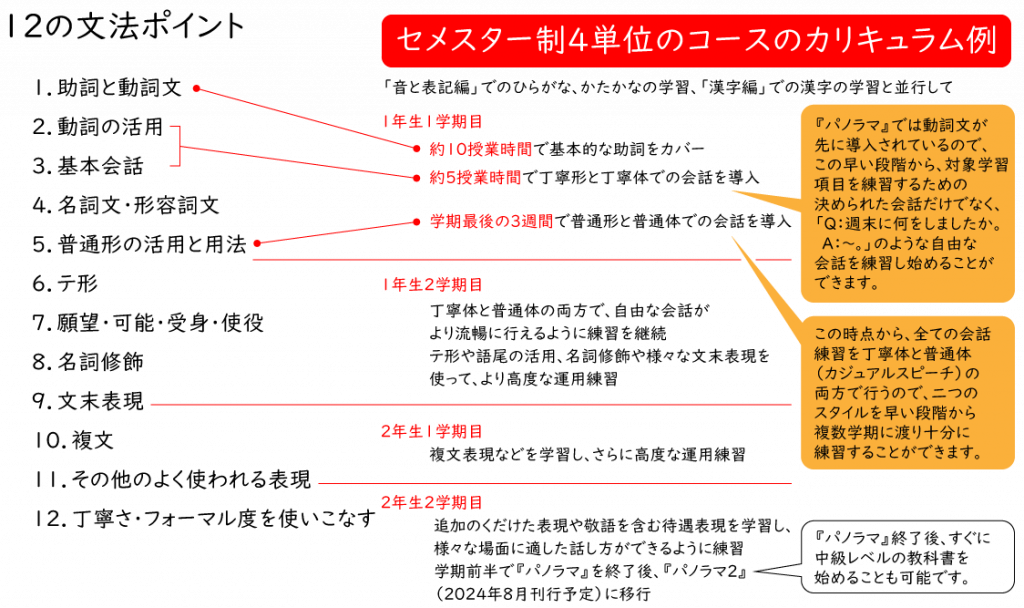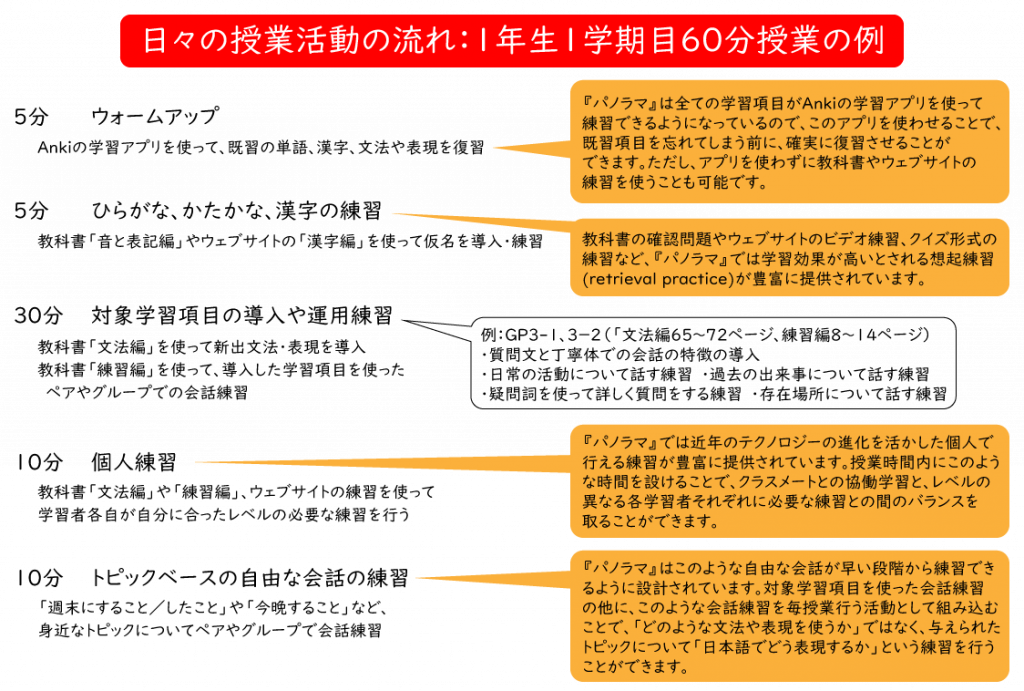This is the website for a series of Japanese language textbooks, Elementary Japanese: PANORAMA – Fast-Track to Mastery in Just 12 Grammar Points and Pre-Intermediate Japanese: PANORAMA Plus – Stepping Toward Intermediate Through 10 Topics. The PANORAMA series helps learners who have no previous knowledge about the Japanese language achieve the intermediate language level efficiently and sustainably.
Elementary Japanese: PANORAMA is a text that introduces all of the material studied at the elementary level of Japanese in one volume. It aims to equip users with a strong foundation of Japanese language skills quickly and reliably. The text also includes the activity booklet that provides various opportunities for individual and communal practice to meet the needs of learner in diverse learning environments.
Pre-Intermediate Japanese: PANORAMA Plus is a beginner-intermediate text that aims to help learners who have completed the beginner level of Japanese continue solidifying their language skills for establishing themselves at the intermediate level. This text can be used not only by those who have studied Elementary Japanese: PANORAMA but also by anyone who has completed the beginner level.
Both texts are designed to take full advantage of today’s technological environment by providing a variety of digital resources that facilitate users’ effective and efficient learning. Below you can find all the digital learning materials referred to in the texts. Please see the usage recommendations in each text (Elementary Japanese: PANORAMA on pp.10-11, Pre-Intermediate Japanese: PANORAMA Plus on pp.7-9) to learn how to use these materials effectively.
Materials for:
For Elementary Japanese: PANORAMA
Key Concept Videos
Each video introduces the key concepts of the appropriate sections. Watch the video when you start studying each of the following sections.
Key Concept Videos
Each video introduces the key grammatical concepts of the appropriate sections. Watch the video when you start studying each of the following sections.
- [p.41] GP1-1. Particles and Word Order
- [p.51] GP1-3. Particles Used Between Two Nouns
- [p.57] GP2-1. Short Forms vs. Long Forms
- [p.65] GP3-1. Questions
- [p.73] GP4-1. Sentences with Predicate Nouns
- [p.76] GP4-2. Japanese Adjectives
- [p.94] GP5-1. Short Form Conjugations
- [p.109] GP6. Te-forms
- [p.128] GP7-1. Overview of the Four Verb Forms
- [p.139] GP8-1. Sentences with Noun-Modifying Clauses
- [p.151] GP9-1. Commonly Used Sentence-Final Expressions
- [p.162] GP9-3 [9]. ~のだ / ~んだ
- [p.164] GP9-3 [10]. ~そうだ (it looks ~)
- [p.167] GP10-1. Commonly Used Connecting Expressions
- [p.189] GP10-4. Embedded Sentences
- [p.213] GP12-1. Verbs of Giving and Receiving
- [p.222] GP12-3. Respectful Language (敬語)
Example Sentence Slides
Below you can access the slides for the example sentences in the Grammar Module. Using these slides, you can simultaneously practice listening to and reading all the example sentences in the module. Some slides include additional example sentences not found in the text. Those sentences are labeled “additional” in the slides.
Grammar Point 1
Grammar Point 2
Grammar Point 3
Grammar Point 4
- pp.73-75 (incl. additional examples)
- pp.76-79 (incl. additional examples)
- p.81 (incl. additional examples)
- pp.82-83
- pp.84-85 (incl. additional examples)
- pp.86-87 (incl. additional examples)
- p.88 (incl. additional examples)
- pp.89-91 (incl. additional examples)
- pp.92-93
Grammar Point 5
Grammar Point 6
- pp.109-110 (incl. additional examples)
- pp.114-115
- p.115
- pp.116-117 (incl. additional examples)
- pp.118-120
- pp.121-124
- pp.125-126
Grammar Point 7
- pp.128-129
- pp.132-133 (incl. additional examples)
- pp.135-136
- pp.137-138
Grammar Point 8
- pp.139-141
- pp.143-144 (incl. additional examples)
- pp.145-147
- p.149
- p.150 (incl. additional examples)
Grammar Point 9
- pp.151-152
- p.153
- pp.154-155 (incl. additional examples)
- pp.156-158 (incl. additional examples)
- pp.158-161 (incl. additional examples)
- p.162
- pp.162-164
- pp.164-165
- p.165
Grammar Point 10
- pp.167-170
- pp.172-174 (incl. additional examples)
- pp.175-176
- pp.176-179
- pp.180-181
- p.182
- pp.182-184
- pp.186-187
- pp.189-190
Grammar Point 11
- pp.192-195
- pp.196-197
- p.197 (incl. additional examples)
- pp.199-200 (incl. additional examples)
- p.200-203
- pp.205-207 (incl. additional examples)
- pp.208-210
- p.211
Grammar Point 12
- pp.213-215
- pp.216-217
- pp.219-220
- pp.223-227 (incl. additional examples)
- pp.229-232
- pp.233-234
- pp.236-238
- pp.239-240
Special thanks to Hina Nishikawa and Reina Anamoto for helping create these materials.
Video Practices and Practice Quizzes
Below you can find video practices and practice quizzes for the exercises marked with the monitor icon in the Practice Module. (The practices labeled “additional” are not included in the Practice Module.)
Sounds and Writing Module
- Practice 1-1
- Practice 1-2
- Practice 2-1
- Practice 2-2
- Practice 2-3
- Practice 2-4
- Practice 2-5
- Practice 3-1
- Practice 3-2
- Practice 3-3
- Practice 4-1
- Practice 4-2
- Practice 4-3
Grammar Module
Grammar Point 1
Grammar Point 2
Grammar Point 3
- Practice 7-3 (additional)
- Practice 8-2 (additional)
- Practice 9-3
- Practice 10-3
- Practice 10-5
Grammar Point 4
- Practice 11-0
- Practice 11-4
- Practice 12-5
- Practice 13-3
- Practice 14-0
- Practice 15-2
- Practice 15-3
- Practice 15-7
- Practice 16-2
- Practice 16-5
- Practice 17-4
- Practice 18-0
Grammar Point 5
- Practice 19-1
- Practice 19-3
- Practice 20-4 (additional)
Grammar Point 6
- Practice 21-0
- Practice 21-2
- Practice 21-5
- Practice 23-3
- Practice 24-2
- Practice 24-5
- Practice 24-7
- Practice 26-3
- Practice 26-5
Grammar Point 7
- Practice 27-0
- Practice 27-4 (additional)
- Practice 28-0
- Practice 29-0
Grammar Point 8
- Practice 30-0
- Practice 31-0 (additional)
- Practice 32-1 (additional)
Grammar Point 9
Grammar Point 10
Grammar Point 11
Grammar Point 12
Special thanks to Hina Nishikawa for helping create some of these video materials.
Preparatory Activities
Newer vocabulary words and expressions that are used for each practice in the Activity Booklet are listed. It is recommended that you go over these words/expressions before beginning each practice.
Grammar Point 3
- [p.08] 7-1. Sentence Practice
- [p.09] 7-3. Conversation Practice
- [p.10] 9-1. Sentence & Writing Practice
- [pp.10-11] 9-2. Conversation Practice
- [p.12] 10-1. Sentence & Writing Practice
- [pp.13-14 & 120] 10-4. Conversation Practice
Grammar Point 4
- [p.15] 11-1. Sentence & Writing Practice
- [p.16] 11-3. Conversation Practice
- [p.16] 12-1. Sentence & Writing Practice
- [pp.17-18 & 121] 12-4. Conversation Practice
- [pp.18-19] 13-1. Sentence & Writing Practice
- [pp.19 & 122] 13-2. Conversation Practice
- [p.20] 14-1. Sentence & Writing Practice
- [p.21] 15-1. Conversation Practice
- [pp.22-23] 15-6. Reading Practice
- [p.23] 15-10. Conversation Practice
- [p.24] 16-1. Conversation Practice
- [p.24] 16-3. Conversation Practice
- [pp.24-25] 16-4. Conversation Practice
- [p.25] 17-1. Sentence & Writing Practice
- [pp.26 & 122] 17-2. Conversation Practice
- [p.27] 17-5. Reading Practice
- [p.28] 18-1. Conversation Practice
Grammar Point 5
Grammar Point 6
- [pp.32 & 123] 21-1. Conversation Practice
- [pp.33 & 123] 21-4. Conversation Practice
- [pp.34-35] 22-1. Conversation Practice
- [pp.35-36] 22-2. Reading Practice
- [pp.36-37] 23-1. Sentence & Writing Practice
- [pp.38-39 & 124] 24-1. Sentence & Writing Practice
- [pp.40 & 125] 24-4. Conversation Practice
- [pp.41 & 126] 24-6. Conversation Practice
- [p.42] 25-1. Sentence & Writing Practice
- [p.44] 25-3. Reading Practice
- [pp.45-46] 26-1. Reading Practice
- [pp.46 & 127] 26-2. Conversation Practice
Grammar Point 7
- [p.48] 27-1. Conversation Practice
- [p.50] 27-4. Conversation Practice
- [p.51] 27-7. Reading Practice
- [pp.52-53] 28-1. Sentence & Writing Practice
- [p.53] 28-2. Writing Practice
- [pp.54-55] 29-1. Sentence & Writing Practice & 29-2. Conversation Practice
Grammar Point 8
- [p.56] 30-1. Sentence & Writing Practice
- [p.57] 30-2. Reading Practice
- [pp.57-58] 31-1. Conversation Practice
- [p.58] 31-2. Reading Practice
- [pp.59-60] 32-1. Conversation Practice
- [p.61] 33-1. Reading Practice
- [p.63] 34-1. Reading Practice
Grammar Point 9
- [p.65] 35-1. Sentence & Writing Practice
- [p.67] 36-1. Sentence & Writing Practice
- [pp.67-68] 36-2. Reading Practice
- [pp.69-70 & 129] 36-6. Conversation Practice
- [pp.70-71] 36-8. Reading Practice
- [p.71] 36-9. Reading Practice
- [p.72] 37-1. Conversation Practice
- [pp.73-74] 38-1. Conversation Practice
Grammar Point 10
- [p.75] 39-1. Reading Practice
- [pp.76-77] 40-1. Sentence & Writing Practice & 40-2. Conversation Practice
- [pp.77-78] 40-3. Reading Practice
- [p.79] 41-1. Sentence & Writing Practice
- [p.80] 41-3. Conversation Practice
- [pp.80-81] 41-4. Reading Practice & 41-5. Writing Practice
- [pp.82-83] 42-1. Reading Practice
Grammar Point 11
- [pp.86-87] 44-1. Sentence & Writing Practice & 44-2. Conversation Practice
- [p.88] 44-4. Conversation Practice
- [pp.88-89] 44-6. Reading Practice
- [p.90] 45-1. Conversation Practice
- [pp.91-92] 45-2. Reading & Writing Practice
- [pp.93-94] 46-1. Reading Practice
- [pp.96-97] 47-1. Reading Practice
- [pp.98-99] 48-1. Reading Practice
- [pp.100-101] 49-1. Conversation Practice
- [p.102] 49-4. Conversation Practice
- [p.103] 49-6. Reading Practice
- [pp.105-106] 50-1. Reading Practice
Grammar Point 12
- [p.108] 51-1. Reading Practice
- [p.109] 51-2. Writing Practice
- [pp.109-110] 51-4. Reading Practice
- [p.112] 52-1. Conversation Practice
- [p.113] 53-1. Sentence & Writing Practice
- [p.114] 53-2. Conversation Practice
- [p.114] 53-3. Writing Practice
- [pp.115-116] 53-5. Writing Practice
- [p.116] 53-6. Reading & Writing Practice
- [pp.117-118] 54-1. Conversation Practice
- [p.118] 54-4. Reading & Writing Practice
Kanji Information and Practice Quizzes
Learners are recommended to follow the following steps when using the Kanji Module:
- Read the “Notes & Tips” in the digital flipbook and learn new kanji information and how to memorize them.
- Using the online quizzes provided under the flipbook, confirm the stroke orders of each kanji character and your knowledge about the new kanji words that you just learned.
- Practice all the kanji you have learned previously using the “cumulative” quizzes.
Anki Digital Flashcards
PANORAMA provides Anki flashcards for practicing hiragana/kanakana, kanji, vocabulary, and the example sentences from the above modules. By utilizing Anki’s spaced repetition system, you can not only memorize material efficiently but also avoid forgetting what you’ve learned. It also helps improve listening skills effectively.
Additional Materials Not Found in the Text
Answer keys for the Comprehension Checks in the Grammar Module as well as the Sentence Practices and Reading Practices in the Practice Module.
English-to-Japanese Glossary formatted for printing
The Japanese-to-English glossary is included in the textbook on pp.247-253.
Vocabulary and Kanji Lists
Here, you can access the vocabulary and kanji lists. Feel free to “Download” as a Microsoft Excel file or “Make a copy” as a google spreadsheet if needed. Both menus can be found in the “File” menu.
Vocabulary Lists
The main list in this spreadsheet includes all of the vocabulary words that appear in the Sounds & Writing Module and Grammar Module. (The exercises in the Practice Module only use words learned in the two modules above and don’t introduce any new vocabulary.) In addition to the main list, there are two additional lists that are separated for each module. You can use the tabs at the bottom of the spreadsheet to access each of the additional lists.
Kanji List
This list includes all of the kanji words that appear in the Kanji Module.
For Pre-Intermediate Japanese: PANORAMA Plus
Answer Keys for the activities in the textbook.
English-to-Japanese Glossary formatted for printing
The Japanese-to-English glossary is included in the textbook on pp.167-183.
Vocabulary and Kanji Lists
Here, you can access the vocabulary and kanji lists. Feel free to “Download” as a Microsoft Excel file or “Make a copy” as a google spreadsheet if needed. Both menus can be found in the “File” menu.
Vocabulary List
This is the list of all the vocabulary words that appear in the text. The words are listed in the order of the first time appearance. (The Japanese-to-English glossary is included in the textbook on pp.167-183.)
Kanji List
This is the list of all the kanji words learned in the Panorama Kanji Module.
In the Panorama series, approximately 540 kanji words are selected from PANORAMA and PANORAMA Plus and a total of 400 new kanji characters are introduced. Those who studied the beginner level of Japanese using PANORAMA can continue learning kanji using the Kanji Module. If you used a different elementary textbook, please check the index of the Kanji Module in the digital flipbook and find the section that you feel is appropriate for starting out.
Kanji Information and Practice Quizzes
In the Panorama series, approximately 540 kanji words are selected from PANORAMA and PANORAMA Plus and a total of 400 new kanji characters are introduced. Those who studied the beginner level of Japanese using PANORAMA can continue learning kanji using the Kanji Module. If you used a different elementary textbook, please check the index of the Kanji Module in the digital flipbook and find the section that you feel is appropriate for starting out.
Anki Digital Flashcards
PANORAMA PLUS provides Anki flashcards for practicing vocabulary, example sentences, and kanji. By utilizing Anki’s spaced repetition system, you can not only memorize material efficiently but also avoid forgetting what you’ve learned. It also helps improve listening skills effectively.















